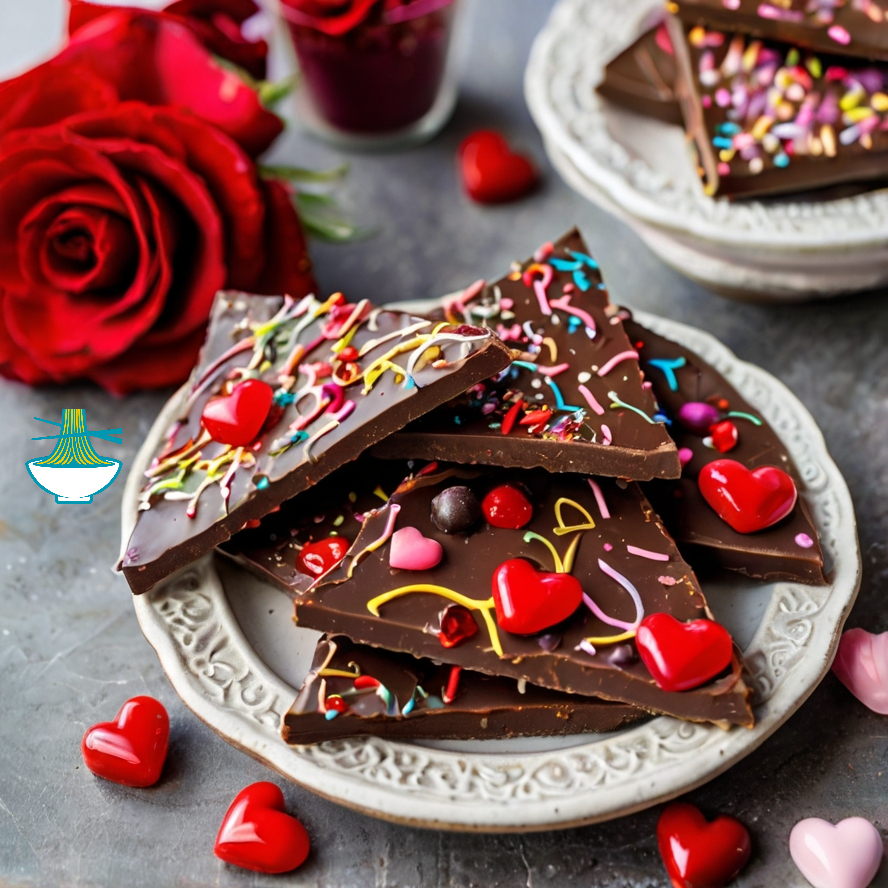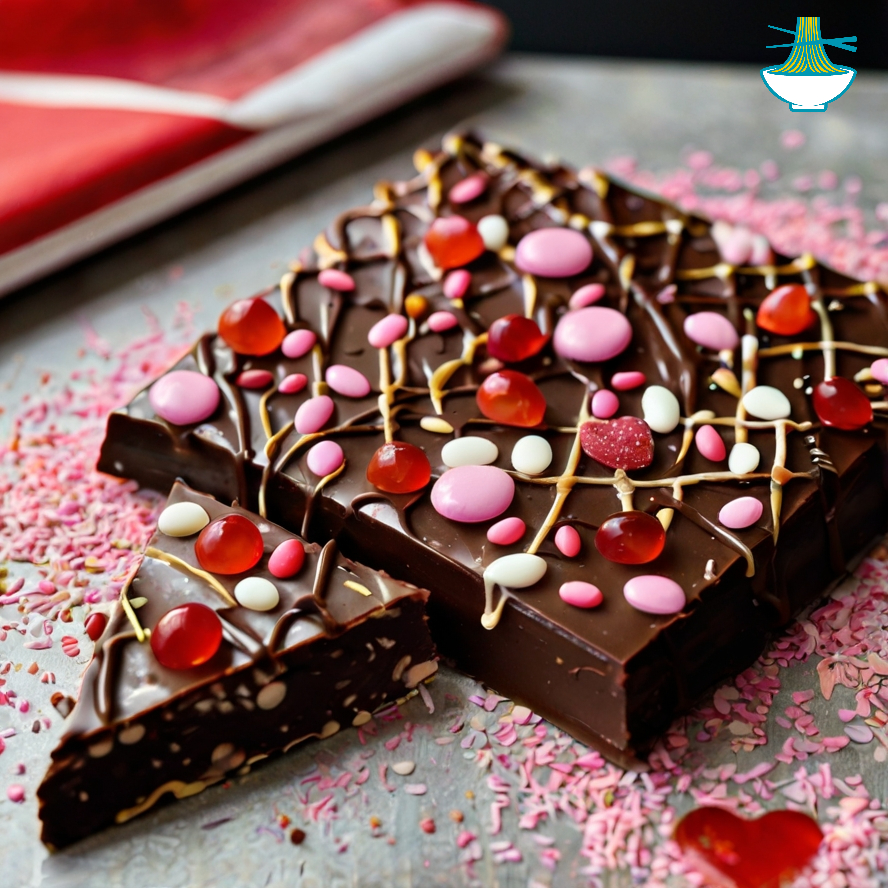Valentine's Day Chocolate Bark is a delightful and festive treat that combines the smooth richness of melted chocolate with an array of colorful toppings. This no-bake recipe makes it easy to create a fun and indulgent treat perfect for sharing or gifting on Valentine's Day. Whether you're treating yourself or preparing a thoughtful chocolate gift for friends and loved ones, this chocolate bark is a simple yet creative way to celebrate the occasion. With vibrant sprinkles, dried strawberries, and candy hearts adorning the chocolate, it offers a visually appealing and deliciously sweet experience. While this treat brings joy to many, it's important to recognize both the benefits and potential downsides of its ingredients. Chocolate, especially dark chocolate, is packed with antioxidants and provides a boost of mood-enhancing compounds, such as serotonin. However, the sweetness and rich toppings can contribute to excess sugar intake, which, when consumed in large amounts, may lead to negative health effects. Enjoying this chocolate bark in moderation ensures you can indulge in its flavors while still benefiting from its positive qualities.
Ingredients:
- 200g milk chocolate (or dark chocolate for a richer flavor)
- 100g white chocolate (for drizzling)
- 1/4 cup dried strawberries, chopped
- 1/4 cup dried cranberries
- 1/4 cup mini marshmallows
- 1/4 cup colorful sprinkles or candy hearts
- 1 tablespoon edible glitter (optional)
Instructions:
- Melt the Chocolate: Start by melting the milk or dark chocolate. To do this, place the chocolate in a heatproof bowl over a pot of simmering water, ensuring the bowl does not touch the water (this is known as the double boiler method). Stir occasionally to ensure even melting. Alternatively, if you prefer using a microwave, place the chocolate in a microwave-safe bowl and heat it in short intervals (about 20-30 seconds), stirring between each interval until the chocolate is fully melted and smooth.
- Prepare the Baking Tray: While the chocolate is melting, prepare a baking tray by lining it with parchment paper. This will prevent the chocolate from sticking and make it easier to remove once set.
- Pour and Spread the Chocolate: Once the chocolate is completely melted, pour it onto the prepared parchment-lined tray. Using a spatula, spread the chocolate into an even layer. Aim for a thickness of around 1/4 inch (6mm), but feel free to adjust depending on your preference. Make sure the surface is smooth for an even finish.
- Drizzle White Chocolate: After spreading the milk or dark chocolate, take the white chocolate and drizzle it over the surface of the chocolate in a swirl pattern. You can either use a spoon or a piping bag to achieve this. This will create a beautiful marbled effect when combined with the next step.
- Create the Marbled Effect: Using a toothpick or a skewer, gently swirl the white chocolate into the melted chocolate. Be careful not to mix too much, as you want the marbled effect to remain visible. The white chocolate should create soft, elegant swirls throughout the dark chocolate.
- Add the Toppings: Once you are happy with the marbled effect, it’s time to add the toppings. Sprinkle the dried strawberries, dried cranberries, mini marshmallows, and colorful sprinkles or candy hearts evenly over the chocolate. Make sure to press them down gently to ensure they stick to the chocolate once it hardens. For an extra festive touch, you can sprinkle edible glitter over the top.
- Chill and Set: Place the tray in the refrigerator to set the chocolate. This process usually takes about 30 minutes to an hour, depending on the thickness of the chocolate. The chocolate should be completely firm to the touch when ready. If you're in a hurry, you can also place the tray in the freezer for 10-15 minutes to speed up the process.
- Break into Pieces: Once the chocolate has set and hardened, remove the tray from the refrigerator or freezer. Using your hands or a knife, break the chocolate into irregular pieces of your desired size. The pieces can range from large shards to bite-sized chunks, depending on your preference.
- Serve or Package: Serve the chocolate bark immediately as a festive treat or package it in a decorative box or cellophane for a lovely homemade gift. It’s perfect for sharing with friends and loved ones or enjoying on your own.
Additional Tips
- How to Store Chocolate Bark: To maintain the freshness and texture of your Valentine’s Day Chocolate Bark, store it in an airtight container in the refrigerator. This will keep the chocolate firm and prevent it from melting. It can be kept for up to two weeks, allowing you to enjoy it long after the holiday. If you prefer, you can also store it at room temperature for up to a week, but keep in mind that warmer environments might cause the chocolate to soften.
- Modification Options for the Recipe: This recipe is versatile and allows for creative modifications. For example, you can add different types of nuts, such as almonds, cashews, or hazelnuts, to enhance the flavor and add crunch. You can also experiment with other dried fruits like apricots, figs, or dates to customize the taste. These adjustments will not only alter the texture but also provide additional health benefits like more fiber and healthy fats.
- How to Serve or Use Chocolate Bark: Valentine’s Day Chocolate Bark is not just a treat but also a thoughtful gift idea. It can be broken into bite-sized pieces and packaged in a decorative gift box or jar for a personal and delicious gift. This treat is perfect for sharing at parties, whether as a snack on a dessert table or wrapped in cellophane as a gift for friends or loved ones. You can also use it as a topping for ice cream or as a garnish for other desserts, adding a festive touch to any celebration.
- Health Effects of the Ingredients: While chocolate bark is a delicious indulgence, it’s important to be mindful of its health effects. The main ingredients like milk chocolate and white chocolate, although tasty, contain sugar and fats, which can contribute to excess calorie intake if consumed in large quantities. Sugar, when consumed excessively, can cause spikes in blood sugar levels and contribute to energy crashes later on. For those with health concerns, such as diabetes or those managing weight, opting for dark chocolate with a higher cocoa percentage (70% or more) can provide antioxidants without the added sugar. Additionally, dried fruits like cranberries and strawberries offer vitamins and fiber, benefiting immune function and digestive health, while mini marshmallows and sprinkles, though fun, add little nutritional value and should be enjoyed in moderation.
Frequently Asked Questions (FAQs)
- Can I replace the milk chocolate with dark chocolate? Answer: Yes, you can use dark chocolate instead of milk chocolate for a richer, more intense flavor. Dark chocolate also contains a higher percentage of cocoa, which provides beneficial antioxidants and may have mood-enhancing properties. It is also lower in sugar, making it a better option for those looking to reduce their sugar intake.
- How can I store Chocolate Bark? Answer: Chocolate bark should be stored in an airtight container in the refrigerator for up to two weeks to keep it fresh and prevent it from melting. If stored at room temperature, it can last for about a week, but the chocolate may soften in warmer environments.
- Can the ingredients be modified to suit a vegan or gluten-free diet? Answer: Yes, you can modify the ingredients to accommodate vegan or gluten-free diets. Opt for dairy-free or vegan chocolate options and use gluten-free marshmallows if needed. Additionally, you can swap out certain toppings for other allergy-friendly options, such as using gluten-free sprinkles or dried fruits.
- What other toppings can I use for Chocolate Bark? Answer: You can add a variety of toppings to personalize your chocolate bark. Some great options include chopped nuts like almonds, walnuts, or pistachios, dried fruits such as figs, apricots, or raisins, or even coconut flakes for a tropical twist. These additions will not only enhance the flavor but also provide additional nutrients and textures.
- Is it possible to make Chocolate Bark without added sugar? Answer: Yes, you can reduce or eliminate added sugar by using sugar-free chocolate or by reducing the quantity of sweet ingredients like marshmallows and sprinkles. Dark chocolate with a high cocoa content generally has less sugar, making it a healthier alternative for those who want to limit their sugar intake.

Nutritional values and benefits
1. Milk Chocolate (200g)
- Calories: 1100
- Carbohydrates: 130g
- Protein: 12g
- Fat: 60g
- Sodium: 50mg
Vitamins:
- Calcium: 150mg (15% DV)
Nutritional Benefit: Milk chocolate is a source of energy from carbohydrates and fats, and provides some calcium, which is essential for strong bones and teeth.
2. White Chocolate (100g)
- Calories: 540
- Carbohydrates: 60g
- Protein: 6g
- Fat: 30g
- Sodium: 40mg
Vitamins:
- Calcium: 120mg (12% DV)
Nutritional Benefit: White chocolate offers a creamy, sweet flavor and contributes to calcium intake, benefiting bone health and supporting dental health.
3. Dried Strawberries (1/4 cup)
- Calories: 100
- Carbohydrates: 24g
- Protein: 1g
- Fat: 0g
- Sodium: 0mg
Vitamins:
- Vitamin C: 30mg (50% DV)
Nutritional Benefit: Dried strawberries are rich in vitamin C, which boosts immune function and promotes skin health, while also providing fiber for digestive health.
4. Dried Cranberries (1/4 cup)
- Calories: 90
- Carbohydrates: 22g
- Protein: 0g
- Fat: 0g
- Sodium: 2mg
Vitamins:
- Vitamin C: 5mg (8% DV)
Nutritional Benefit: Dried cranberries provide antioxidants, which support the immune system and help combat oxidative stress in the body.
5. Mini Marshmallows (1/4 cup)
- Calories: 80
- Carbohydrates: 22g
- Protein: 0g
- Fat: 0g
- Sodium: 5mg
Vitamins:
- No significant vitamins
Nutritional Benefit: Marshmallows offer a quick source of sugar for energy, though they should be consumed in moderation as they are mainly made up of simple sugars.
6. Colorful Sprinkles (1/4 cup)
- Calories: 90
- Carbohydrates: 24g
- Protein: 0g
- Fat: 2g
- Sodium: 0mg
Vitamins:
- No significant vitamins
Nutritional Benefit: While sprinkles primarily add color and sweetness, they contribute little to nutrition and are best used in moderation as a decorative topping.
7. Edible Glitter (1 tablespoon, optional)
- Calories: Negligible
- Carbohydrates: Negligible
- Protein: Negligible
- Fat: Negligible
- Sodium: Negligible
Vitamins:
- No significant vitamins
Nutritional Benefit: Edible glitter is a fun addition for aesthetic purposes, adding sparkle without contributing to the nutritional content of the treat.
Valentine's Day Chocolate Bark is a perfect way to celebrate love with a sweet, creative treat. It's a fun and easy recipe that everyone will enjoy, and it makes a fantastic gift for loved ones. Enjoy making this simple yet festive dessert for your Valentine!


Comments